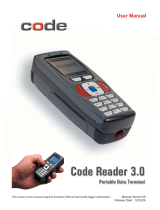
C004386_06_CR2500_User_Manual - iv
Save Settings
2.10 - Continuous Scan ................................................................................................................ 30
2.11 - Continuous Scan Settings ................................................................................................ 31
2.11.1 - Continuous Scan - Sleep Time Out .......................................................................... 31
2.11.2 - Continuous Scan - Trigger Delays ............................................................................ 31
2.11.3 - Continuous Scan - Duplicate Scan Suppression ...................................................... 31
2.12 - Motion Detection Scan Settings ....................................................................................... 31
Chapter 3 - CR2500 Programming: Symbology Settings ............................................................. 32
3.1 - Aztec Symbology .................................................................................................................. 33
3.2 - Codabar Symbology ............................................................................................................. 33
3.3 - Codablock F Symbology ...................................................................................................... 33
3.4 - Code 11 Symbology ............................................................................................................. 33
3.5 - Code 39 Symbology ............................................................................................................. 34
3.6 - Code 93 Symbology ............................................................................................................. 34
3.7 - Code 128 Symbology ........................................................................................................... 34
3.8 - Composite Symbologies ...................................................................................................... 35
3.9 - Data Matrix Symbology ........................................................................................................ 35
3.10 - GoCode Symbology .......................................................................................................... 35
3.11 - Interleaved 2 of 5 Symbology ............................................................................................ 36
3.12 - Maxicode Symbology ......................................................................................................... 36
3.13 - Matrix 2 of 5 Symbology ..................................................................................................... 36
3.14 - Micro PDF417 Symbology ................................................................................................. 36
3.15 - MSI Plessy Symbology ...................................................................................................... 37
3.16 - NEC 2 of 5 Symbology ....................................................................................................... 37
3.17 - Optical Character Recognition (OCR) ................................................................................ 37
3.18 - PDF 417 Symbology .......................................................................................................... 37
3.19 - Pharmacode ....................................................................................................................... 38
3.20 - Postal Symbologies ............................................................................................................ 38
3.21 - QR Code Symbology ......................................................................................................... 38
3.22 - GS1 data bar (formerly RSS) Symbology .......................................................................... 39
3.23 - Telepen Symbology ............................................................................................................ 39
3.24 - UPC/EAN/JAN ................................................................................................................... 39
Chapter 4 - Reader Feedback and Special Settings ..................................................................... 40
4.1 - Volume and Vibration Settings ............................................................................................. 41
4.2 - Code Readability Index ........................................................................................................ 41
4.3 - Backlight Intensity Settings .................................................................................................. 42
4.4 - Backlight Timeout Settings ................................................................................................... 42
4.5 - Targeting Settings................................................................................................................. 42
4.6 - Reader Power Off Settings................................................................................................... 42
4.7 - Reader ID and Firmware Version ......................................................................................... 43
4.8 - Reader Settings Lock ........................................................................................................... 43
4.9 - Lock-out Link Mode .............................................................................................................. 43






















